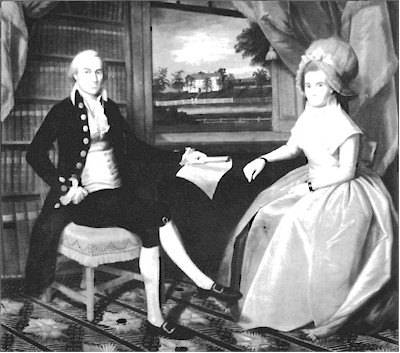
The Judiciary Act of 1789: Charter for U.S. Marshals and Deputies
| Quick Links for U.S. Marshals Information: Site Map | Contacts | Fugitives | Assets | Career | Local - Districts |
 |
| Home >>
History >> The Judiciary Act of 1789 The Judiciary Act of 1789: Charter for U.S. Marshals and Deputies
|
|
Pictured to the right is the official portrait of Chief Justice of the Supreme Court Oliver Ellsworth and his wife Abigail. Ellsworth was the principle author of the judiciary Act of 1789, the charter for the federal judiciary system and the Marshals Service. |
|
 Senate Bill Number One of the First Session of the First Congress became, after lengthy and heated debate, the Judiciary Act of September 24, 1789. The Act provided a charter for the federal judicial system by specifying the jurisdiction and powers of the district and circuit courts, and the qualifications and authority of federal judges, district attorneys, court clerks, U.S. Marshals, and Deputy Marshals. Invited by Article 111, Section 1, of the newly ratified Constitution to "ordain and establish" a court structure for the new national government, the first Senate moved quickly to the task. But its labors were immediately embroiled in a bitter contest between the Federalists, who wanted a strong federal government, and the Anti- Federalists, who jealously guarded the rights of the states. The result was a typically American compromise. The Federalists stymied an Anti-Federalist motion to limit the district courts' jurisdiction to admiralty and maritime cases only. The Anti-Federalists succeeded in limiting the appellate review of federal courts to issues of law, excluding questions of fact. The final form of the Act satisfied neither side, for most of the participants recognized it as a clumsy, inefficient system. As soon as the Act passed, the Congress directed the Attorney General to report on ways to improve it. Yet, the judicial system's very clumsiness and inefficiency has served it well in successfully achieving its contradictory purposes of exerting federal authority while protecting the rights of the states and the freedoms of individual citizens. In governing ourselves, we Americans have never had an easy time determining how much or how little government we wanted. Our system of federal courts accurately reflects this fundamental indecisiveness. From this perspective, we can better understand the difficult tasks that generations of Marshals and Deputies have confronted as they tried to enforce the law upon a people who, while recognizing the necessity for law, have never been comfortable with any encroachment on their personal liberties: This article briefly describes the origins of the office of Marshal in the Judiciary Act of 1789. The theme explored here runs consistently throughout the history of the Marshals Service. For 195 years, Marshals and Deputies have performed the duties originally assigned them by the Judiciary Act of 1789. Their history is also the story of a nation's unending attempt to balance the need for law and order against the demand for individual freedom and the rights of the states.
|